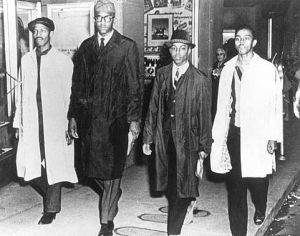February One: The Story of the Greensboro Four (2003)
February One: The Story of the Greensboro Four was released on April 10, 2003, in the USA. The American film was produced by Video Dialog Inc. The film was written and directed byDaniel Blake Smith and Tom Vickers. The movie was displaying how the four college freshmen in North Carolina change the prejudice and fight for civil rights by sitting in a lunch counterpart[1].
Plot

On February 1, 1960, Jibreel Khazan, David Richmond, Franklin McCain, and Joseph McNeil who are college freshmen decided to have a sit-in at a Woolworth's lunch counter in North Carolina. They had been planning for months to do the sit-in. They decided to use their best clothes on Sunday, bought several groceries, and went into the restaurant. As they came in, they cross the line of the dining area which could only be used by the white people. They sat on and asked to be served by waiters. People looked at them as it was something new for African Americans who dare to sit-in in at the lunch counter in southern cities in the country. Waiters refused to serve them, the manager wanted to dismiss them, a police officer came to the scene and hit one of their hands with a nightstick. However, the Greensboro Four remained calm and sat on the seats of the dining area. Since they did not do any violence, nobody would dare to beat them as the Greensboro Fourdid not interfere with anybody. The restaurant then decided to close earlier and the Greensboro Four went back with empty hands but they were not arrested, beaten, or even killed by anybody in the scene and considered to be a safe approach to express their rights to have a sit-in at the restaurant. Later on, these college freshmen are called the Greensboro Four and aspire many people to speak up for their rights and fight against segregation and Jim Crow law[3].
Controversy
Before the 1960s, sitting in lunch counterpart in a restaurant for African Americans was considered a crime. Racism and discrimination were found everywhere including within the restaurant. As shown in the film, stepping over the line of a dining area and taking a seat for African Americans could be arrested, beaten, or even killed. Furthermore, when the Greensboro Four dared to sit in the dining area and asked to be served, the waiter refused to serve African Americans. Also, when the police came to the scene, a police officer hit them with a nightstick against one of their hand. Though at the end of the day they did not get beaten by anybody, nobody would assist them to serve the food and eventually, the store manager decided to close the shop earlier without even serving them any food at all[4].
Black Empowerment
The Greensboro sit-ins were a brave action for these college freshmen to do as many African Americans at the time die due to racism. Four of them had planned for months and try to fight for their rights to eat and sit-in in the dining area of the restaurant. As they did it, nobody would dare to disturb or beat them since they did not do any violence. They would just remain sit-in for the whole day and these were seen by many people which eventually aspire people to speak up. Not only that, a white grandma even supported the Greensboro Four as she said "Boys, I am so proud of you"[5]. The Greensboro Four has inspired many African Americans in the south. The Jim Crow law seemed to disappear as the African Americans decided to resist the segregation by taking sit-ins in the restaurant peacefully. Within 2 months after the Greensboro sit-ins, restaurant sit-ins for African Americans have been established in 70 southern cities. The sit-ins have become a civil rights movement as it reveals the Black Power Movement and captures the public attention non-violently[6].
References
- ↑ February One: The Story of the Greensboro Four (2003). IMDb. Retrieved January 21 2021
- ↑ Greensboro First Day Smithsonian National Museum of American History. Retrieved January 21 2021
- ↑ FEBRUARY ONE: The Story of the Greensboro Four PBS. Retrieved January 21 2021
- ↑ Christopher Wilson. THE MOMENT WHEN FOUR STUDENTS SAT DOWN TO TAKE A STAND Smithsonian Magazine. Retrieved January 21 2021
- ↑ Michael Graff. The Story of the Greensboro Four and the Sit-In Movement Our State Magazine. Retrieved January 21 2021
- ↑ Feb. 1, 1960: The Greensboro Sit-in Begins Zinc Education Project. Retrieved January 21 2021